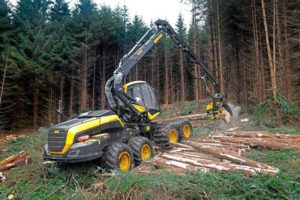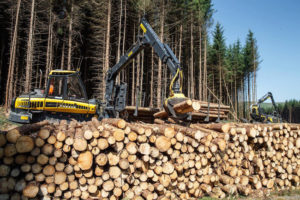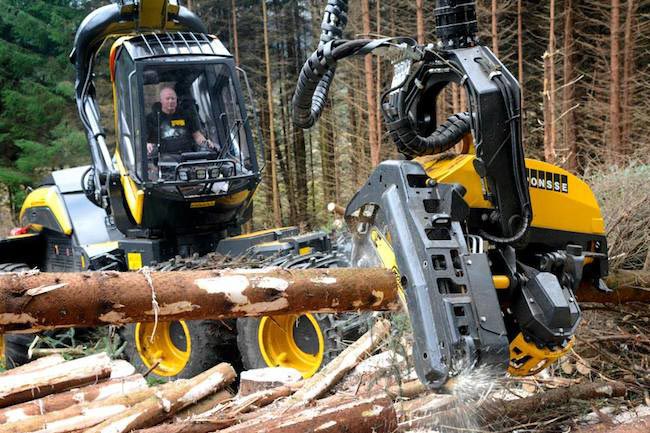The Harvesting Contractor (FWN31)
30 September 2018If you have some mature woodland, current timber prices mean it’s a great time to harvest. But what’s actually involved in turning your trees into cash? Davie Dick, of Dick Brothers Ltd, has been in the business of forestry harvesting since 1975 and shared with us some of his advice.
Planning the job
The first step is to have a harvesting contractor look at the site and discuss access and constraints. With large-scale commercial forestry blocks, the necessary infrastructure is usually already in place but on smaller estates and farm woodlands road construction may need to happen before harvesting can begin. Timber stacking areas, or benches, and a turning area will also need to be planned so it’s best to have a site meeting with the harvesting and roading contractors together right from the start. This is crucial to ensure that the layout of the site infrastructure allows harvesting to run efficiently and construction is financially viable, given the expected value of the timber. Road construction is discussed in more detail here.
The contractor should advise on the size of the area needed for stacking timber. This depends on the size of the woodland and the number of different products to be cut, as each category of timber needs to be stacked separately. Choosing a suitable location for benches is also crucial. They should allow the forwarder to access the stack from within the wood, without needing to run on the road, and the timber lorries to pull up alongside.
If lorry access tot he wood isn’t practical it may be worth considering using a field as extraction route or for stacking. The disruption will be temporary and, provided you plan ahead and arrange for the harvesting to take place at the right time of year, operations shouldn’t leave lasting damage. It’s important to consider what time of year will be best for harvesting operations. Allowing time for the infrastructure to be built in good time will avoid any delays with construction causing delays to harvesting. You should also consider how forestry operations will fit around other seasonal activities such as lambing, silage recovery, game shooting, even the Royal Highland Show!
While you can’t control the weather, it’s best to be prepared for potential disruption, particularly if harvesting through the winter months. Work needs to stop in high winds prevent the harvester operator maintaining control of where the trees will fall. Putting in good drainage before work begins will minimise problems with runoff and silting of watercourses but these need to be monitored, particularly during wet weather and maintained throughout the job.
An experienced contractor will likely have worked on similar sites before so have a good idea of problems that could arise and how to deal with them. While there’s always the risk of unforeseen events, identifying potential issues before they happen will allow you to include a budget contingency.
Machinery
A pair of standard machines – one harvester and one forwarder – have sufficient capability for most sites. For more complex sites, combinations of different machines and equipment might be needed to access the whole crop. Band tracks can be fitted over wheels to tackle the rough terrain of a harvesting site and floatation tracks can be used on soft ground conditions. On steeper or softer ground, smaller and lighter, or fully tracked, low ground pressure machines might be more suitable. Skyline and winch systems can be used to extract timber from extremely steep areas. These high-cost operations are only financially viable for high-value stands but do allow even the most inaccessible areas to be harvested.
A small proportion of trees may need to be felled by hand. For example, a medium-sized harvester might be able to handle all the trees in a crop except those around the edges, which tend to be larger in diameter and have thicker branches. Bringing in a chainsaw operator to fell and de-limb the edge trees may be more efficient overall than using a larger harvester which is overkill for the rest of the job. Hand cutting may also be the best approach to felling areas of very steep ground that aren’t large enough to justify bringing in specialist machines.
Costs
Working rate is usually calculated for a pair of machines on a weekly basis, and includes costs of diesel, breakdown and repairs. In real terms, the cost depends on how the challenges of the site affect the team’s production levels – how much timber the team can cut per week. Getting a realistic estimate of this will weigh up the cost per ton against the predicted sale value.
Technology
The harvester head measures the diameter, length and taper of each stem as it cuts and, based on the previously cut trees, the computer in the cab works out what the best possible combination to maximise high-value products cut from that tree.
However, the operator’s skill and judgement are necessary to assess the straightness of the stem and decide whether to agree with the computer’s suggestion or override it to avoid cutting a log that isn’t straight enough for the sawmill to accept.
Details of every log are recorded by the computer and this information gives the harvesting manager real-time updates on progress, as well as the volume and types of timber products being cut. By knowing what is actually being extracted the harvesting team can be instructed to prioritise different products to maximise the total value of the crop.
Safety
Before work begins, a site-specific risk assessment should be done with the operators. In areas with poor mobile phone coverage, workers may carry GPS enabled devices which allow them to check-in at regular intervals and  make SOS calls if necessary. The risk to members of the public will vary depending on the location but it should always be assumed that people may approach the area. In any location, warning signs need to be displayed around the harvesting site and in areas of heavy recreational use banksmen may be required to divert walkers, cyclists and horse riders, or direct the operator to stop work while they pass through the risk zone. Many people visiting forests may not think of them as dangerous work sites, or appreciate the extent of the risk zone around operating forestry machines: two tree lengths plus the length of the boom from forwarders; 200m from the harvester head. If public footpaths run in close proximity to the harvesting site, it may be best to put up signs directing them to a safer alternative route.
make SOS calls if necessary. The risk to members of the public will vary depending on the location but it should always be assumed that people may approach the area. In any location, warning signs need to be displayed around the harvesting site and in areas of heavy recreational use banksmen may be required to divert walkers, cyclists and horse riders, or direct the operator to stop work while they pass through the risk zone. Many people visiting forests may not think of them as dangerous work sites, or appreciate the extent of the risk zone around operating forestry machines: two tree lengths plus the length of the boom from forwarders; 200m from the harvester head. If public footpaths run in close proximity to the harvesting site, it may be best to put up signs directing them to a safer alternative route.
Signs should also be placed around timber stacking areas to warn people of the risks. In high use locations consider taping off the area as an extra deterrent to anyone tempted to climb on the stacks. Avoiding stacks becoming too high helps to reduce the risk, with a general rule of thumb that the stacks should be no higher than the length of the logs in the stack.
Extraction routes should avoid passing under overhead powerlines where possible. If harvesting within two tree lengths of overhead powerlines, these will need to be temporarily shut down while the surrounding trees are felled. Arranging this with the power operator well in advance is essential to avoid delays to harvesting.
Keeping the timber flowing
Usually the pair of machines will be run by two operators who work together regularly. The number of lorry loads to be extracted per week should be agreed at the start of the job but the harvesting team need to keep in regular contact with the haulier and harvesting manager and notify them of any delays or changes to production rate. This will help to avoid timber sitting at roadside too long or lorries leaving the site below capacity. Half-full lorries can also be avoided by being realistic in the number of products to be cut. For example, cutting 10 different products from a small woodland would be impractical, as each type needs to be stacked and transported separately. Towards the end of a job, reducing the number of products being cut will avoid leaving small volumes of multiple products for the last lorry runs.
For heavy-duty machines working on rough terrain, mechanical problems and breakdowns are inevitable. Operators should be able to deal with common issues themselves, although if parts are required delays will depend on the distance to the nearest supplier. For more major problems, contractors may have specialist mechanics on-call to respond quickly and minimise downtime.
The harvesting contractor will need to plan how to work across the site in order to maintain a wind-firm edge on the side of the prevailing wind as the risk of windthrow increases once the crop has been opened up by felling.
The current demand for small roundwood for biomass also means that existing areas of windthrown trees may be worth extracting. The process is slower than harvesting standing trees, particularly if the trees have fallen in different directions. The time and difficulty of extracting windthrown trees need to be carefully weighed against the potential value of the timber.
For thinning operations, specialist machines that are narrower and more manoeuvrable may be available. Operator skill is needed to avoid damaging standing trees, particularly when using a selective approach to remove trees of low stem diameter, rather than just entire rows.
Agree at the outset how you want the site to be left at the end of harvesting, bearing in mind the obligation to restock the site, or an equivalent area, within 5 years. A good harvesting contractor will keep the site as tidy as possible throughout operations. All branches and non-merchantable timber (stem diameter less than 7cm) should be collected into brash mats, which are used as running surface for the machines within the wood. This leaves the rest of the site clear for restocking. Complete residue recovery can be financially worthwhile, removing all brash, debris and un-merchantable timber for the biomass market.
Experienced contractors will be able to find a solution to most problems but it’s crucial that all the involved parties work together and communicate clearly and openly from the start. Listen to the advice of the experts and weigh up the pros and cons of all the options. All jobs can be done but you need all the information to decide what is realistic and financially viable, given the value of the timber.
Key points
- Make sure the site location of stacking areas works for the harvesting contractor
- Identify potential problems on the site early on, and plan solutions
- Most sites can be harvested with the right machinery – but be sure the value of the timber makes it worthwhile
- The harvesting team should maintain regular communication to keep the lorries running
- Harvested sites must be restocked
Leona Baillie, SAC Consulting & Davie Dick, Dick Brothers Ltd
Sign up to the FAS newsletter
Receive updates on news, events and publications from Scotland’s Farm Advisory Service


